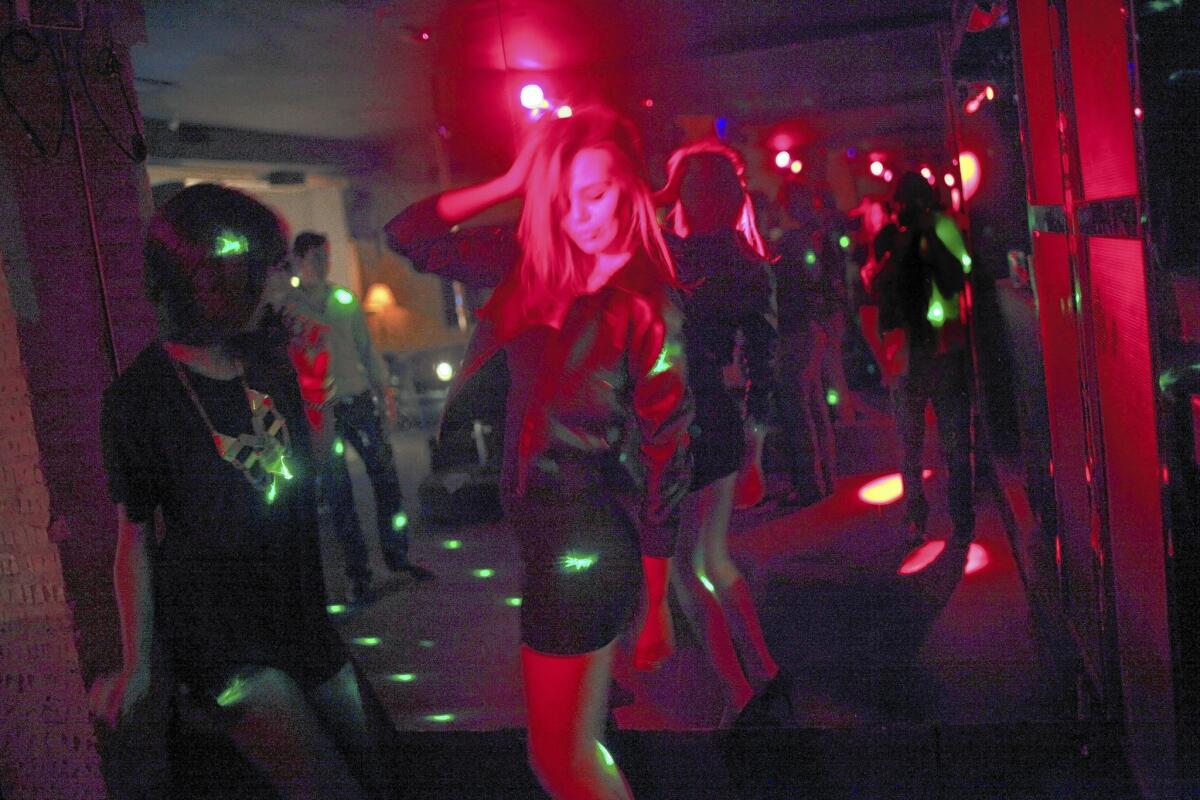At Boston Marathon bombing site, all signs point to normality
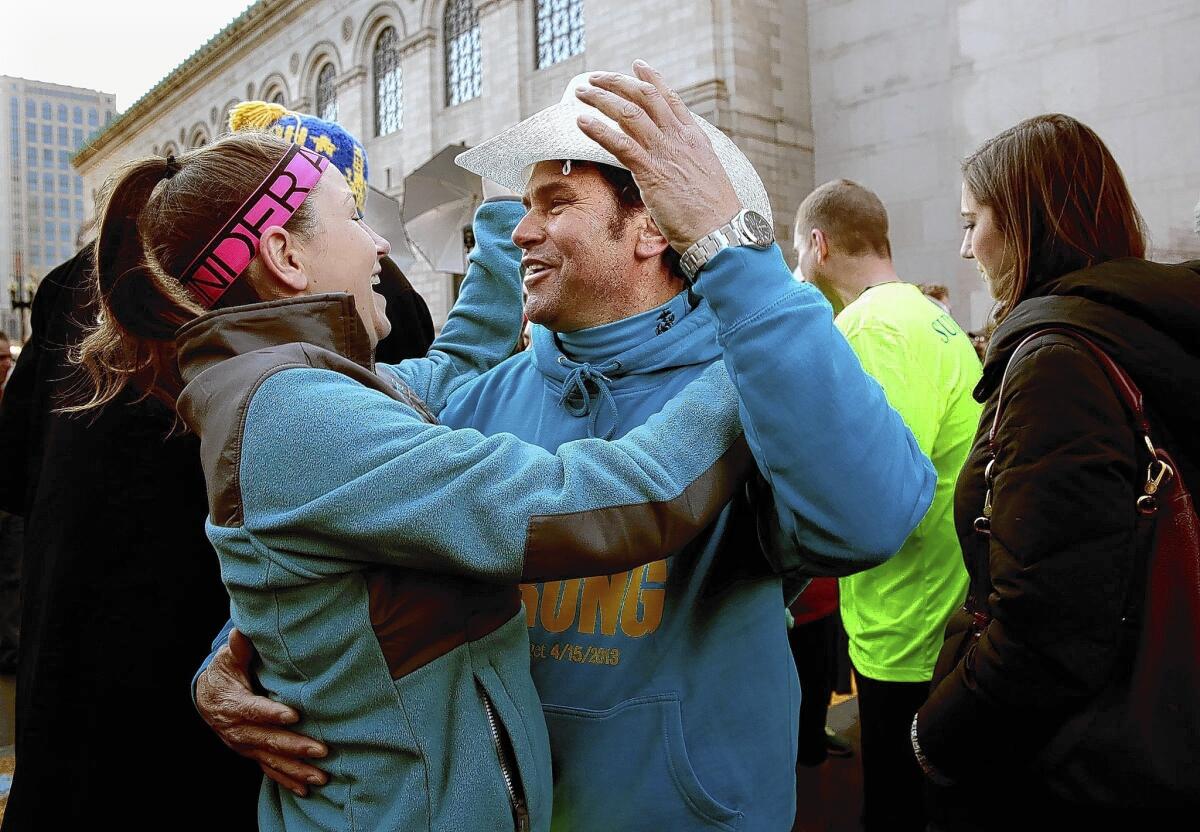
There’s still grief and anxiety, but the scene on Boylston Street shows how Boston has endeavored to move on after the worst terrorist attack on U.S. soil since 9/11.
- Share via
On an April morning a year after two bombs tore through the crowd at the Boston Marathon finish line, there's little sign that destruction once visited Boylston Street.
Bleary-eyed students and hard-hatted construction workers wait at Dunkin' Donuts as a bus rattles past. A bellhop scrubs the shiny door handles at the Lenox Hotel, while a jogger in orange running clothes snaps a photo of the finish line, recently repainted on the pavement in advance of this year's race.
"This is where it happened? Here?" says one man walking down Boylston as a friend points knowingly to the sidewalk outside Forum Bar & Restaurant, where the second pressure-cooker bomb went off.
The photographs, notes and running shoes that formed impromptu memorials last year have been carted away for display at a nearby library. Tammy Baker, in from Texas to visit her son and daughter-in-law, found the absence of overt signs of the tragedy puzzling.
"I think my biggest impression is that I don't see any recognition of it," Baker says. "I understand Bostonians don't want to glorify it, but it's not a matter of glorifying it. It's more — recognizing it."
In a town dotted with historical markers, the scene on Boylston is indicative of how Boston, which prides itself on being tough, endeavors to move on after the worst terrorist attack on U.S. soil since Sept. 11, 2001.
Not that Boston has forgotten the three lives lost and more than 260 people injured. A civic memorial service will be held Tuesday, the first anniversary of the April 15 attack, and there's still anxiety here — a dread that things won't ever get back to normal. But there's a determined sense, too, that they already have.
So if visitors to this two-block stretch of Boylston Street aren't sure this is really where the carnage unfolded, to some Bostonians that's a good thing.
"That's what the bombers want: They want to be memorialized in history. You kind of want to take that away from them," says Jason Reed, a Boston cop for 25 years standing near the former LensCrafters, whose blown-out storefront appeared in countless news photographs.
Still, Reed says, he sometimes thinks that it's strange that the area doesn't have a name, like ground zero in New York.
"This is the spot where the bomb went off, but I think to Boston, it's just the finish line. And I think that's symbolic," he says. "In Boston, you take a lickin', and you keep on tickin'."
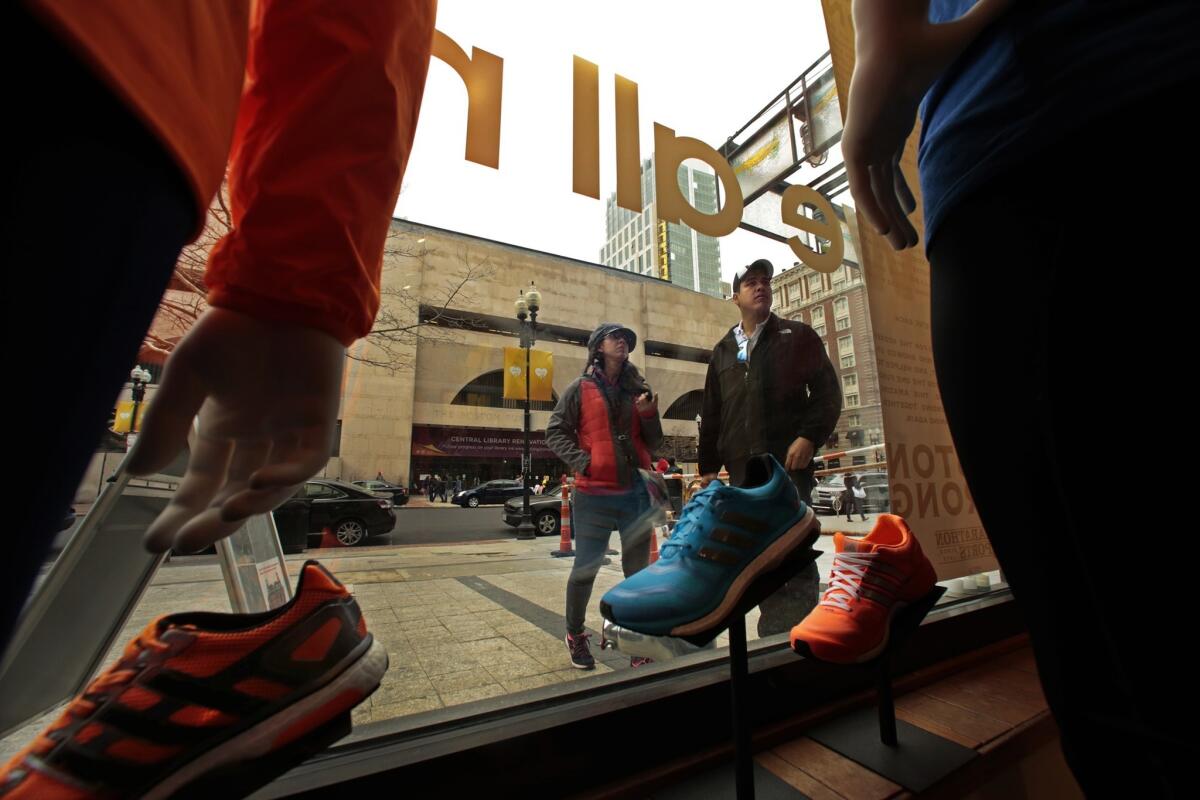
Running shoes and clothes fill the display window at Marathon Sports, steps from where the first bomb exploded. A poster facing the sidewalk thanks all the people who helped get the store back up and running after the bombing. (Carolyn Cole / Los Angeles Times) More photos
This is, after all, a prime area for locals and tourists alike, just blocks from Boston Common, under the glimmering shine of the John Hancock Tower. Duck Tours come down Boylston on their route around the city. Instead of memorials, there's a New Balance ad on a bus stop that reads, "Love Boston," and banners inside stores reminding residents to be "Boston Strong." The ravaged storefronts have been repaired.
"It was a year ago," shrugs George Simopoulos, district manager at Dunkin' Donuts.
But if the external scars are gone, Simopoulos adds, others will take longer to go away.
"It's not just what you see outwardly," he says, "but what people are experiencing inside."
Jose Cruz, who works at Lord & Taylor, thinks of the bombing when he glances at the fashionably dressed mannequins posed at the store's spacious Boylston Street entrance.
He was working in the menswear department when he heard an explosion and suddenly saw people stampeding in, running toward the back of the store. He recalls later seeing the trampled and dismembered mannequins they left behind.
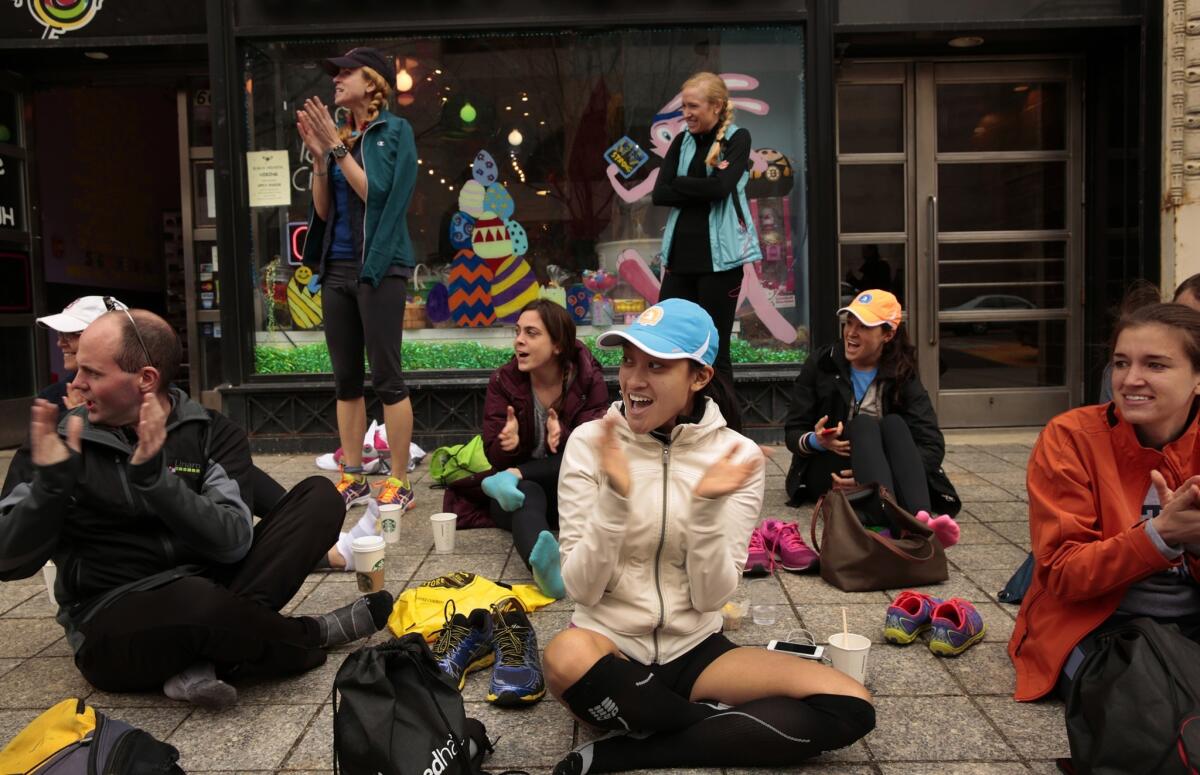
Cecille Avila, center, and other runners with the One Fund charity gather in front of Marathon Sports after a 20-mile training run. The charity raises money for victims of the bombing and their families. (Carolyn Cole / Los Angeles Times) More photos
Cruz now avoids large crowds, and saw a therapist the store brought in for employees. He's already asked for the day off on Marathon Monday, April 21, so he won't have to be near those mannequins.
"I was crying for a week," he says. "I'm not planning on being here this week. I don't want to go through it again."
The spot that makes Shane O'Hara, the manager of Marathon Sports, remember what happened that day is right outside his store. It's one of the few places on Boylston bearing any sign of the attack, though it's easy to miss.
On a patch of sidewalk someone has scrawled "krystle" in tiny blue writing above a blue heart. Krystle Campbell was standing here on marathon day. Campbell, 29, died, as did 23-year-old Lu Lingzi and 8-year-old Martin Richard.
"Every time you stand there, you think, 'Someone died here,'" O'Hara says. "They can change the sidewalk and the building front, but to me, I still see the LensCrafters window being completely shattered, the banners on the floor, the stains. That won't leave me until I don't go out there anymore."

An unidentified Boston Marathon runner clutches a blanket around her shoulders as she walks near Copley Square after the bombing. (Winslow Townson / Associated Press) More photos
O'Hara and others from Marathon Sports rushed out after the explosion, pulling clothes from racks to use as tourniquets. He also still gets nervous in big crowds, like when the Red Sox paraded down Boylston last fall to celebrate their World Series victory.
But he and others say that, despite the shivers they get when they walk over certain spots on Boylston, positive things have emerged from tragedy.
For years, O'Hara has organized a Wednesday night running group. This year, its ranks swelled into the hundreds, as more people signed up to run the marathon's 26.2 miles, their way of saying Boston will endure.
O'Hara didn't run the marathon last year, but is this year and is hoping to cross the finish line before 2:50 p.m., the time the first bomb detonated, so he can observe the moment with the rest of his store.
Every time you stand there, you think, 'Someone died here.'”— Shane O'Hara
The days that followed the bombing were terrifying for all of Boston, as authorities struggled to find the suspects, Dzhokhar and Tamerlan Tsarnaev. Even after Tamerlan was killed and Dzhokhar captured, Boylston Street was closed for days as authorities combed the huge crime scene for clues.
Being shut down for so long was tough on business. But then the city reopened the street and launched an effort called "Boylston Strong," in which parking meters were free to encourage residents to support local stores and eateries. In those days, many merchants say, business was better than ever, even if they did get sick of "explosion tourists" — people wanted to know all the grisly details.
When Forum finally reopened after renovations, customers packed the bar to order martinis and huge burgers on brioche buns, part of a morale-building effort locals called "Forum Strong."
"It's a tough-as-nails city," says Joshua Glover, a restaurant manager.
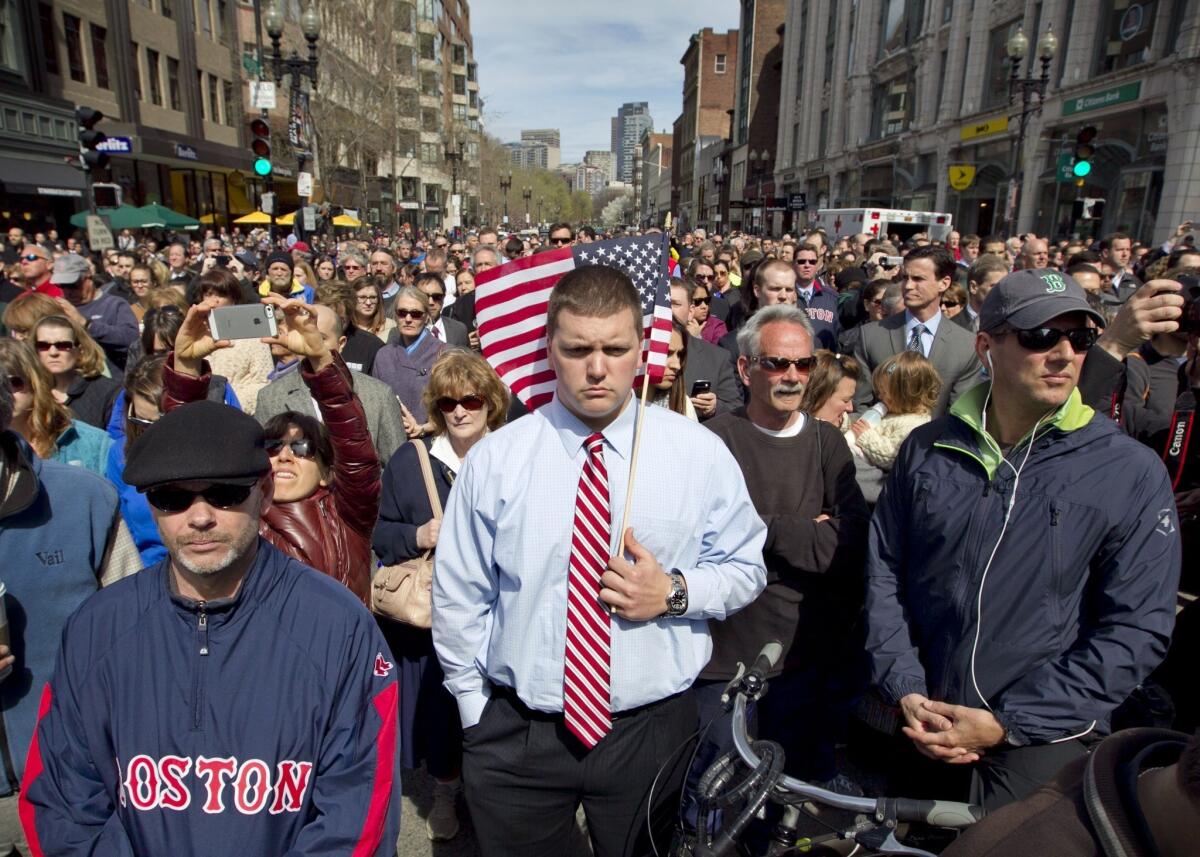
On April 22, 2013, a week after the bombing, Bostonians gather for a moment of silence in tribute to the victims of the marathon bombing on Boylston Street near the race finish line. (Robert F. Bukaty / Associated Press) More photos
The city has created a remembrance committee to oversee plans for a permanent memorial, but no plans have emerged yet. Perhaps a more permanent memorial seems to be taking shape in how Bostonians go about their daily business.
Ashley Paolini, 26, works at the Apple store a little further down Boylston, so she has passed the bomb site hundreds of times on her way to work. It makes her remember the absolute silence of the city last April 15, as terrified and mournful residents like her walked home along the Charles River.
She knows people who will not come outside to watch the marathon this year because they're afraid of what might happen. But all those trips past Forum, she says, have steeled her nerves.
She's not scared anymore. She and friend Matisse Reischl, 24, plan to do the exact same things they did last year.
They'll have brunch — and maybe a beer — at the Pour House Bar & Grill, and then cheer on the runners in front of Marathon Sports. It may be last year's bombing spot, but to them, and other Bostonians, it's just the finish line.
Follow Alana Semuels (@AlanaSemuels) on Twitter
Follow @latgreatreads on Twitter
More great reads
In Syria, a shrinking city struggles on between air raids
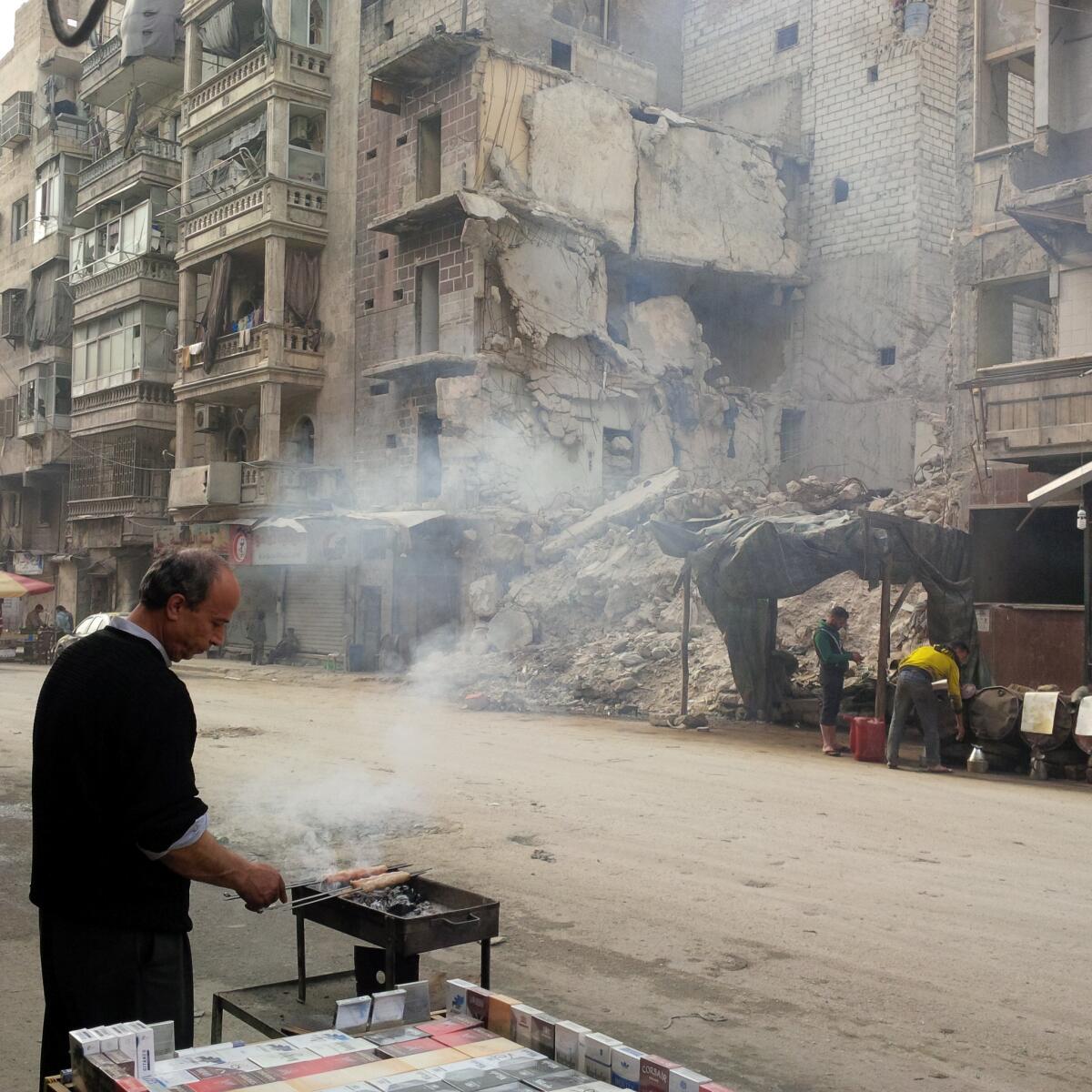
In Aleppo, Syria’s largest city, a kebab vendor works in the midst of a destroyed building. As Syria’s war rages on, Aleppo is a city under gradual demolition, with a shrinking civilian population struggling to survive.
Every day we see the names of the dead scrolling across the TV screen; they've just become numbers.”
Arts blossom in a 'garage salon' in Bell

We don't have plays, we don't have museums, we don't have anything.”
Sign up for Essential California
The most important California stories and recommendations in your inbox every morning.
You may occasionally receive promotional content from the Los Angeles Times.
